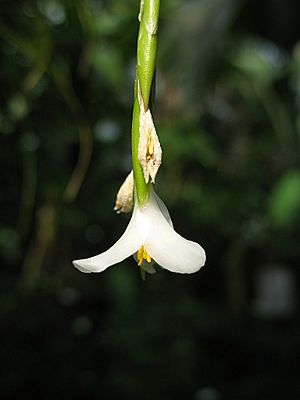Tillandsia alvareziae facts for kids
Quick facts for kids Tillandsia alvareziae |
|
|---|---|
 |
|
| Scientific classification | |
| Genus: |
Tillandsia
|
| Species: |
alvareziae
|
Tillandsia alvareziae is a special kind of plant. It belongs to the genus Tillandsia, which are often called "air plants." These plants are unique because they do not need soil to grow. Tillandsia alvareziae is found only in Mexico. This means it is endemic to that country.
Contents
What Are Air Plants?
Air plants, or Tillandsia, are amazing plants. They are part of the Bromeliaceae family. Unlike most plants, they do not grow in soil. Instead, they attach themselves to other plants, rocks, or even telephone wires. They are not parasites, though. They do not harm the plants they attach to. They just use them for support.
How Do Air Plants Get Food and Water?
Air plants have special leaves. These leaves are covered in tiny, fuzzy scales called trichomes. Trichomes help the plant absorb water and nutrients. They take in moisture directly from the air. This includes rain, dew, and even fog. They also get nutrients from dust and decaying leaves around them. This unique way of living helps them survive in many different places.
Where Does Tillandsia alvareziae Live?
Tillandsia alvareziae is a native plant of Mexico. Being "endemic" means it grows naturally only in this region. Mexico has many different climates. This includes dry deserts and humid forests. Air plants can adapt to many of these conditions. They often grow in trees in tropical or subtropical areas. This allows them to get plenty of light and air circulation.
Life Cycle of Tillandsia
The life cycle of an air plant is very interesting. It starts from a seed or a small "pup." A pup is a baby plant that grows from the base of the parent plant.
How Tillandsia Reproduce
- Seeds: Air plants produce flowers. These flowers can be very colorful and beautiful. After flowering, the plant produces seeds. These seeds often have feathery parachutes. This helps them float on the wind. They can then land on a new surface and start to grow.
- Pups: Many air plants also reproduce by growing pups. These pups are small clones of the parent plant. They grow from the base of the mature plant. Once they are big enough, they can be separated. They can also stay attached to form a clump. This is a common way for air plants to spread and create new colonies.
After an air plant flowers and produces seeds or pups, the parent plant slowly dies. However, the pups continue to grow. This ensures the plant's survival for many generations.
See also
 In Spanish: Tillandsia alvareziae para niños
In Spanish: Tillandsia alvareziae para niños

